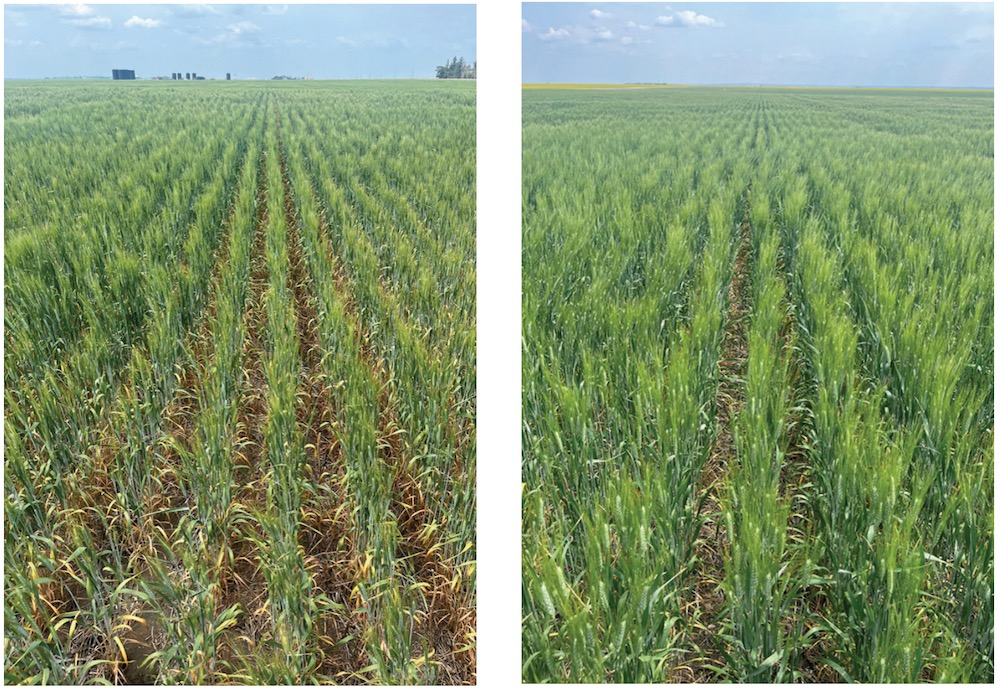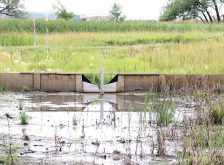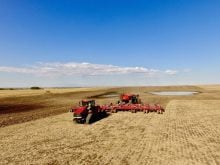You may not think leaving stubble just a bit taller would make much of a difference — but field scale research in Saskatchewan is showing even two more inches of stubble height, for example, can trap snow that could translate into about $40 or more per acre in extra yield.
That’s not just wishful thinking, says Saskatchewan crop consultant Mike Palmier, owner of Max Ag Consulting at Plenty, about 70 km northeast of Kindersley. Along with some general observations, he’s conducted field-scale research trials that show leaving stubble taller makes a difference.
On one research project, monitored over the fall of 2022 and through the 2023 growing and harvest seasons, crop grown on areas with taller stubble produced six to eight bushels more canola per acre compared to adjoining strips of field with shorter stubble. The taller stubble trapped more snow, which helped carry the crop through a dry growing season.
Read Also

Cancer agency reclassifies another herbicide ‘probably carcinogenic’
The WHO’s cancer research agency has now put atrazine, a herbicide well known to corn growers, in the same potential-hazard category where the agency put glyphosate.
“If we get a good heavy snowfall over winter that packs into those stubble rows, I figure that each inch of stubble height will produce about 1.1 bushels of canola,” says Palmier, looking at research conducted last year. “So, for example, if you leave stubble two inches taller than you normally do, that moisture could produce two more bushels of canola and if the market value is around $18 per bushel, you’re looking at close to $40 more yield per acre.”
READ MORE: Drought preparedness through soil and crop management
Palmier admits conditions will vary, so not everyone will see the same results, but the key message for producers is to think about leaving crop stubble as tall as possible, and if the snow comes there is at least a good chance it will translate into more moisture and higher yields.
“In many respects stubble height may seem like a small thing, but when you have extremely dry growing conditions, those little things can make a difference,” he says. “We can’t control the weather, but perhaps we can do a better job of capturing and making use of the moisture that does come.”

Field observations
Palmier, who launched Max Ag in 2019 and, now with a staff of six, works with clients across central Saskatchewan, says field observations in 2021 and 2022 that prompted him to launch the field-scale research trials that continue in 2024.
“We’ve had three extremely dry growing seasons in central Saskatchewan as well as other parts of the Prairies,” he says. The summer of 2021 was extremely dry, for example, but then there was some rainfall in September that caused a problem with regrowth.
“There were standing canola crops and then the fall moisture caused seeds to germinate, so we also had a lot of regrowth. It made for a challenge at harvest, with more crop stubble left behind.”

That fall there was a heavy snowfall, and the following growing season farmers were seeing higher yields in the fall of 2022 on crops grown on fields where stubble had been left thicker and taller. Taller stubble, in particular, appeared to have trapped more snow, resulting in more moisture, which led to higher yields.
In another situation, Palmier points to a farmer with a poor canola stand due to the drought in 2021. With his combine equipped with a stripper header, he harvested a few test strips and was only getting three or four bushels per acre, so decided to leave the rest of the field unharvested. He owned a disc drill and knew he’d be able to seed through that unharvested crop the following year. In November 2021 came heavy snowfall, which was caught by that standing stubble.
“The spring of 2022 that field was seeded to durum and there was a visual difference in crop growth, between the strips that had been combined and the area of the field that had taller crop residue,” Palmier says. “You could easily see it in satellite imagery throughout the whole growing season. On the strips of field where the farmer had made a few passes with the combine, almost nothing was growing, but on that area of the field where the canola crop had been left unharvested, it trapped more snow, the moisture went straight into the ground and it produced a decent durum crop.”
Realizing something was happening because of this taller stubble, Palmier set up an on-farm research trial with that same farmer for the fall of 2022. They chose one canola field where part of the field was harvested with the combine with a stripper header, leaving stubble as tall as possible, even up to 18 and 24 inches in height. While alternate strips for the crop were harvested with a combine equipped with a conventional header leaving stubble at eight to 10 inches in height. Weather stations with moisture sensors were set up on each treatment, with the Crop Intelligence app used to interpret the data. In the fall of 2022 there was good snowfall again and also variable winds, which helped move the snow around and into the stubble.

The 2023 experience
“For the 2023 growing season we measured about 20 mm (roughly 0.75 inch) more plant available moisture at the start of the year on the stripper header strips than on the conventional header strips,” Palmier says.
The rest of the growing season was not particularly kind to the crop. From May until mid-August there was only a little over 82 mm, or three inches, of rainfall, with the biggest rainfall after June 3 amounting to 11 mm, or less than half an inch.
Overall, it was about 39 per cent of the average growing season rainfall — and on top of dry conditions there were plenty of hot days. Between June 5 and Aug. 15 there were 22 days in which temperatures reached above 30 C.

On this field with alternating strips of crop grown on tall and shorter stubble, canola plants showed a difference in growth pattern. The weather station had soil moisture probes at various levels or intervals which included 10, 20, 30, 50, 70 and 100 cm in depth — that is, four inches down to about 40 inches.
Palmier says the crop roots on the two treatments reached the 10- and 20-cm depths at about the same time; however, after that, the crop seeded on the stripper header stubble reached 30 cm two days earlier, and 50- and 70-cm depths six days earlier than the short stubble crop.
“That tells me the crop on stripper header stubble appeared to be more vigorous, it had moisture but also the taller stubble most likely helped to reduce abiotic stress factors by providing more shade to plants and protecting plants from the wind, and other stressors,” Palmier says.
He also found the crop on the stripper header stubble started the year with more moisture and ended the growing season with less soil moisture than the shorter-stubble crop. Again, it was an indicator of more robust plants, developing more roots and using more moisture.
Overall, in comparing yield between the two harvest treatments, the crop with the taller stubble yielded six to eight more bushels per acre than crop grown on the shorter stubble.

Palmier says not every farm can handle stubble that’s 15 to 20 inches tall, because not every seeding system can work through that much standing crop residue.
“But the point is, if a producer can leave stubble even two or three inches taller — go from eight to 10 or from 10 to 12 inches — it can make a difference in how much snow is trapped and how much moisture is available to the crop,” he says.
READ MORE: Crop residues’ rewards versus risks
He points out there are several factors that will affect how much snow is trapped and how much moisture infiltrates into the soil:
- Leave stubble as tall as possible to accommodate your seeding system.
- Do a good job of straw spreading and residue management.
- If there is fall moisture and the ground freezes, there is increased risk of moisture runoff when the snow melts. If the soil doesn’t freeze, moisture will most likely infiltrate into the soil.
- Of course you need snowfall, but wind is important too. If winds are blowing from different directions during snowstorms, that will help to fill in both sides of the stubble rows.
- Plan to have a field harvested with tall stubble next to a pulse crop field. Pulse crops, such as peas and lentils, usually don’t have much standing residue after harvest, so when there is a snowstorm, snow from the lentil field could blow into the adjoining field with taller stubble.
“There are only so many things we can control, but we can set things up to take advantage of snow and moisture if or when it does come,” Palmier says. “And particularly during extremely dry conditions every little bit helps — small changes in management can make a difference.”
Palmier will be monitoring fields with crops seeded into different stubble heights during the 2024 growing season as well.
















